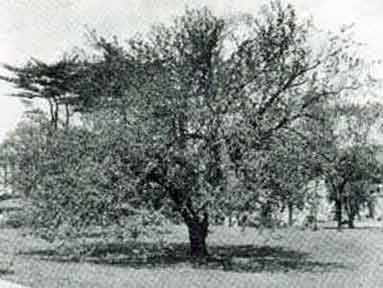By HENRY CLEPPER
Page 1 [1] | Page 2
Number three is the almond, Prunus communis. This small tree is a member of the rose family. It probably originated in western Asia and the Mediterranean region. The almond tree is mentioned in the works of Theophrastus, a Greek philosopher and naturalist of the third century B. c., who wrote a history of plants. Although almonds are produced within the United States, more than one million dollars worth is imported annually.
Number four is the apple tree, Pyrus malus. It produces one of the leading fruits of the world; it is the most important in North America and probably in the entire north temperate zone. Plant researches indicate that the apple originated in southern Europe and Asia Minor. In prehistoric times it was known and used by the Lake Dwellers of Italy and Switzerland about ten or fifteen thousand years ago during the New Stone Age.
Number five is the fig tree, Ficus carica, which grew originally in southern Asia and Europe, whence it has been introduced into other sub-tropical lands. In America, the fig is grown in the Gulf States and in California, and is the source of the dried figs of commerce. The cultivation of the fig is mentioned in the writings of Archilochus, a Grecian poet, about 700 B. C.
Number six is the white mulberry, Moms alba. It is native to India and. Mongolia, and it has been grown in China since ancient times for its leaves, the chief food of the silkworm. The bark was once widely used in paper making. The white mulberry has been grown in America since 1830.

A SILK WORM'S PARADISE: The white mulberry
Number seven is the olive tree, Olea europea. It is mentioned prominently in Homer's Odyssey (about 1000 B. C.), and in old Hebrew writings, and was without doubt cultivated by the ancient Egyptians. Its chief products are its fruit and the oil of the fruit. Once of great economic importance only in dry countries, the olive is now extensively grown in Mediterranean Europe, Syria, South Africa, and Australia. Culture of the olive in America is largely confined to California.
Number eight is the lemon tree, Citrus limonia. Originating in India, the lemon has been cultivated for some 2500 years, and is now in world-wide use. It thrives in tropical and sub-tropical lands, and in the United States, chiefly in Florida and California. The lime, a variety of the lemon, was also anciently cultivated in India. It, too, is an important fruit, but less popular than the lemon.
Number nine is the cinchona tree, Cinchona calisaya, of Peru and Bolivia, the source of quinine, one of the important drugs in medicine. Cultivation has been increasing ever since the. bark of the tree was introduced into Europe in 1639.
Number ten is the rubber tree, Hevea brasiliensis. Although under cultivation for less than 100 years, and extensively grown for less than 40 years, the rubber tree is among the most important in our present civilization. From it, as everyone knows, comes the juice that, when hardened, yields all the numerous rubber products of commerce. The trees are grown in Mexico, South America, Africa, and the East Indies. It would probably be no exaggeration to say that, of all the trees mentioned as being used by man since prehistoric times, the rubber tree, though the latest to be cultivated, is the one which he could least afford to give up.
Although these ten trees are listed as the world's most important, it is realized that others have claims nearly as great. The cherry, for example, one of the world's leading fruits, has been in cultivation almost as long as the lemon tree. The orange, though one of the most popular of American fruits, has been cultivated for a relatively short period of time. It was not developed until the Middle , Ages, and was quite unknown to the ancient Greeks and Romans.
The cocoa tree supplies cocoa, chocolate, and cocoa butter, but it is not of world-wide importance. The coffee tree has been cultivated for only about 500 years; and though the bean is used extensively it is probably less generally used than tea. Among other important species are the apricot, peach, pear, pomegranate, quince, mango, and clove. None of these, however, deserve a place on the list of the "ten most important".
It will be noted that the list fails to mention the great lumber producing trees of the world. The chief reason for this omission is because few of them actually have been cultivated for their wood alone, and, furthermore, none is of such outstanding importance that its products cannot be duplicated by other species. The redwoods and big trees, for example, are unique in size and grandeur, but they are not of exceptional economic importance. Similarly, the cedars of Lebanon are unique in historical interest, but not otherwise remarkable.
In short, the supreme test of a tree's importance is the use mankind has made of it and his need of it. The writer has named his list of ten. Now, you name yours.
Page 1 [1] | Page 2
